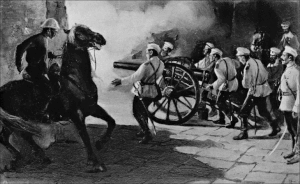Battle of Peking (1900)
| Battle of Peking | |||||||
|---|---|---|---|---|---|---|---|
| Part of the Boxer Rebellion | |||||||
 Russian cannons breaking the gates of Peking. |
|||||||
|
|||||||
| Belligerents | |||||||
|
|
|
||||||
| Commanders and leaders | |||||||
|
|
|
||||||
| Strength | |||||||
| 18,000 | 80,000 | ||||||
| Casualties and losses | |||||||
| 60 killed 205 wounded |
Unknown but heavy | ||||||
The Battle of Peking, or historically the Relief of Peking, was the battle on 14–15 August 1900, in which a multi-national force, led by Britain, relieved the siege of foreign legations in Peking during the Boxer Rebellion. From 20 June 1900, Boxer forces and Imperial Chinese troops had besieged foreign diplomats, citizens and soldiers within the legations of Austria-Hungary, Belgium, Britain, France, Italy, Germany, Japan, Netherlands, Russia, Spain and the United States within the city of Peking.
The first attempt to relieve the legations by a force of over 2,000 sailors and marines commanded by British Admiral Edward Seymour was turned back by strong opposition on 26 June.
On 4 August a second, much larger relief force, called the Eight-Nation Alliance, marched from Tientsien (Tianjin) toward Peking. The alliance force consisted of about 18,000 soldiers (4,300 Russian infantry, Cossacks and artillery; 8,000 Japanese infantry; 3,000 British, mostly Indian infantry, cavalry and artillery; 2,500 US soldiers and Marines with artillery; and an 800-man French (Indochina) brigade with artillery). Austria, Italy, and Germany—although they were members of the Eight-Nation Alliance—contributed no significant number of soldiers to the relief force at this time.
...
Wikipedia
